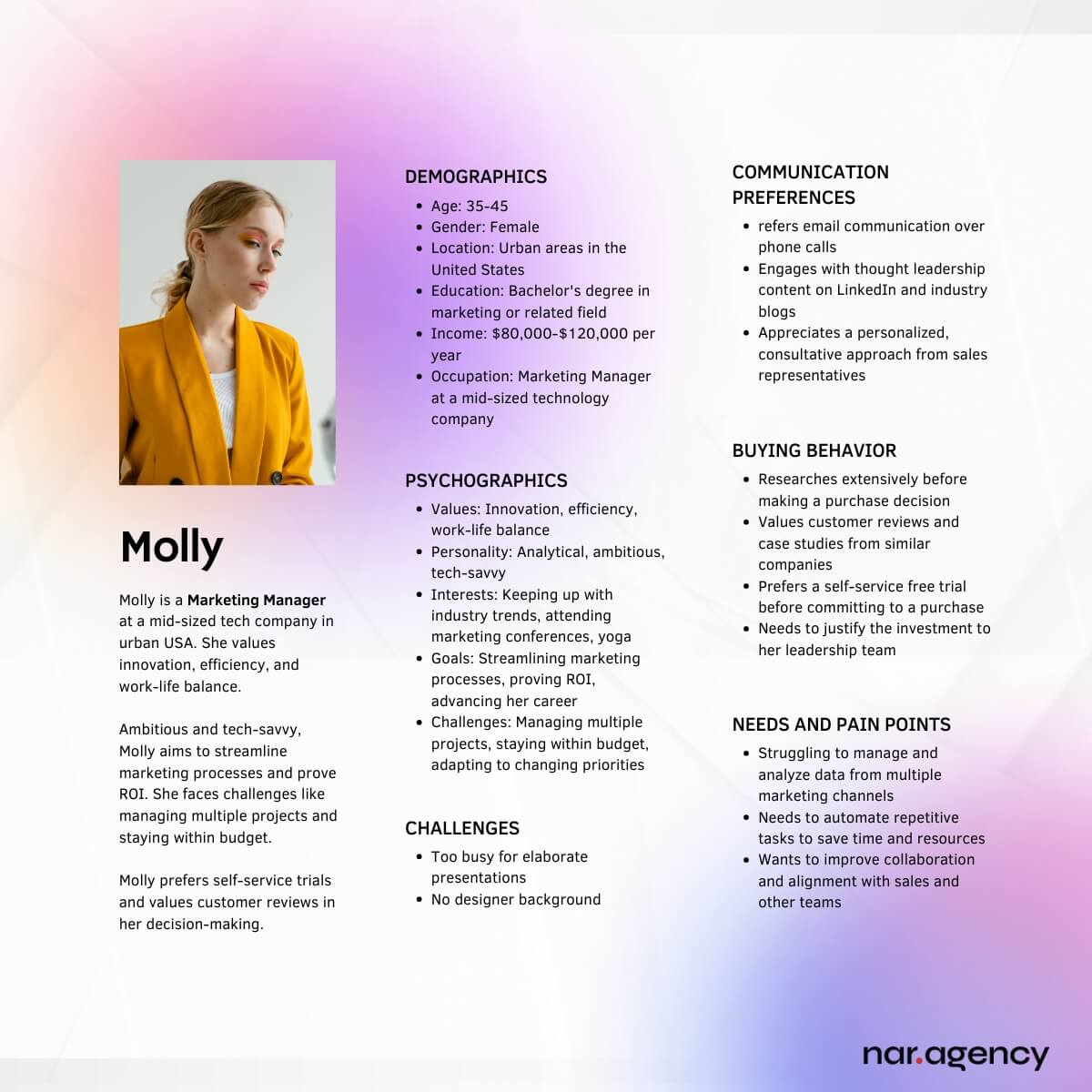Table of Contents
The Treasure Map to Your Ideal Customers
There’s no greater prize than finding your ideal customers – the ones who will become loyal, profitable advocates for your brand. But uncovering this valuable treasure isn’t easy. That’s where the Ideal Customer Profile (ICP) comes in.
An ICP is the multidimensional portrait of your most valuable buyers – a strategic framework that goes far beyond simple demographics.
Learn more about digital strategies in our Digital Strategy Small Business Guide.
It’s a treasure map revealing the unique DNA of the customers who will derive the greatest benefit from your offerings.
Creating a well-defined ICP is necessary for aligning your business efforts with customer expectations and driving sustainable growth. In fact, companies with a clear ICP are 67% more likely to exceed their sales goals. That’s the kind of transformative impact an ICP can have.
In this guide, we’ll explore the concept of the Ideal Customer Profile, why it’s a business essential, and provide a step-by-step process for creating your own customer treasure map. Get ready to uncover the riches that lie in truly understanding your ideal buyers.
Key Takeaways
- An Ideal Customer Profile is a strategic framework defining your most valuable, profitable customers.
- Developing an ICP helps you focus marketing, tailor products, and make informed business decisions.
- To craft an ICP, you'll need to gather and analyze data from successful customer stories, surveys, interviews, and market research.
- Implementing an ICP involves refining your marketing, choosing the right outreach channels, and measuring effectiveness.
- Regularly refining your ICP ensures you adapt to market changes and stay aligned with your evolving target audience.
Understanding the Concept of an Ideal Customer Profile

Defining the Ideal Customer Profile (ICP)
An Ideal Customer Profile (ICP) is a strategic framework that defines the most valuable customers for a business based on specific attributes. It is a high-level blueprint that encapsulates the characteristics of the customers who would benefit the most from your product or service.
This isn’t just a description of any customer – it’s a detailed profile of your perfect customer. An ICP helps you focus your marketing and sales efforts on the people who are most likely to become loyal, profitable buyers.
To create a useful Ideal Customer Profile, you need to consider factors like:
Demographics: Age, gender, income, location, job title
Psychographics: Interests, values, lifestyle
Behavior Patterns: Buying habits, brand loyalty
Needs and Pain Points: The specific problems your product or a service solves
By understanding these key components, you can craft marketing messages and product features that truly resonate with your ideal customers.
See how design plays a role in this in our article on Small Business Branding Essentials.
The Importance of an ICP for Business Strategy
An ICP is a strategic tool that guides your business towards the customers who will get the most value from your offerings. By aligning your strategies with your ideal customers, you can:
Increase customer satisfaction and loyalty
Optimize your marketing spend and ROI
Inform product development to better meet customer needs
Make data-driven decisions across your entire business
When used effectively, an ICP can have a significant impact on your business performance. Companies that have a well-defined ICP are:
50% more likely to acquire new customers
30% more likely to generate higher revenue from marketing efforts
67% more likely to exceed their sales goals
By focusing on the right customers, you avoid wasting time and resources on people who aren’t a good fit for your products or services. This makes your marketing more efficient, your sales process more effective, and your overall business strategy more successful.
Components of an Ideal Customer Profile
The key components of an Ideal Customer Profile are the building blocks that create a comprehensive understanding of your target customer. Going beyond just demographic information, these components paint a holistic picture that reveals why your ideal customers think, feel, and behave the way they do.
Demographics:
Age, gender, location, income level
Job title, industry, company size
Education, marital/family status
Demographic data provides the factual foundation of who your ideal customers are. This information helps you understand the objective characteristics of your target audience.
Psychographics:
Personality traits (e.g. analytical, adventurous, price-conscious)
Values and beliefs (e.g. environmentally-conscious, family-oriented, status-driven)
Interests, hobbies, and lifestyle preferences
Psychographic data dives into the subjective drivers that influence your ideal customers’ decision-making and behaviors. This reveals the “why” behind their actions.
Behaviors:
Purchasing habits (e.g. frequency, average order value, preferred sales channels)
Product usage patterns (e.g. feature preferences, pain points, loyalty)
Online and offline engagement (e.g. website interactions, social media activity)
Behavioral data shows how your ideal customers interact with and experience your product or service. This information can uncover opportunities to better meet their needs.
Challenges and Pain Points:
-
Key problems or obstacles your ideal customers face
-
Frustrations with existing solutions in the market
-
Unmet needs that your product/service can address
Understanding the specific challenges and pain points of your ideal customers is crucial for positioning your offering as the ideal solution. This helps you craft compelling messaging and product features.
Build Your Ideal Customer Profile
Download Our ICP Resources:
ICP Checklist: Use our step-by-step checklist to quickly identify the essential demographics, psychographics, behavioral patterns, needs, and pain points of your ideal customers. Perfect for a quick start in tailoring your strategies.
ICP Template: Dive deeper with our comprehensive ICP template. Create a detailed and actionable profile that drives targeted and effective marketing, sales, and product development strategies.
Now that we understand the concept and the components of an Ideal Customer Profile (ICP), let’s explore how to gather the data needed to inform its creation.
Gathering Data to Inform Your ICP

Reviewing Successful Customer Stories
To understand who your dream clients are, start by looking at your top success stories. Identify what these customers have in common and use that information to refine your Ideal Customer Profile (ICP). Here’s how you can break it down:
Look at the 10 most recent customers who gave you the highest NPS (Net Promoter Score).
Determine the common traits among your most profitable customers.
This approach helps you create a more effective lead qualification process.
Remember, the goal is to attract customers who will be satisfied with your product or service, leading to better retention and positive feedback. This practice should be done at least every quarter to ensure your Ideal Customer Profile remains accurate and relevant. Incentivizing customers to share their experiences can be beneficial too. Offer them a discount or a gift card as a thank you for their time.
Conducting Customer Surveys and Interviews
To understand your customers better, conduct surveys and interviews. Our analytics and tracking services can help you gather valuable insights to inform your ICP development.
Surveys are more structured and can reach a larger audience, while interviews allow for more in-depth, qualitative insights. This helps you learn about their preferences, needs, and the problems they face with your product or service. Make sure to ask open-ended questions to get detailed responses. Here’s how to get started:
Prepare your questions: Focus on what you want to learn from your customers. Ask about their experiences, choices, and what features matter to them. For example, “What challenges do you face in your role that our product helps address?” or “How does our service compare to others you’ve used?”
Choose your interviewees: Start with customers who match your ideal customer profile. Aim for a mix of new and long-term users. Consider incentivizing participation with gift cards or discounts to increase response rates and show appreciation for their time.
Set a schedule: Plan for initial interviews and then regular check-ins, like two per month, to keep up with changing preferences. Record and transcribe interviews for easier analysis and sharing of insights within your organization.
Unlock Deep Customer Insights!
Download Customer Research Tools:
- Customer Survey Template: Use our comprehensive survey template to collect crucial data from your target audience, refine your Ideal Customer Profile, and tailor your offerings to meet their specific needs.
- Customer Interview Guide: Conduct effective customer interviews with our step-by-step guide, designed to uncover your customers’ needs, preferences, and pain points for deeper, qualitative insights.
These downloadable resources complement each other and can be used together for a comprehensive approach to customer research. Feel free to customize the templates to fit your specific needs and target audience.
Utilizing Market Research to Identify Customer Traits
Market research is a powerful tool for discovering who your ideal customer is. By analyzing data from surveys and focus groups, you can pinpoint the traits that define your most valuable customers. This information is crucial for creating a profile that truly represents the people most likely to buy from you.
Review customer demographics like age and income.
Look at customer interests and what they value.
Examine purchasing behaviors to understand buying decisions.
Once you've collected this data, you can start to see patterns.
Maybe your ideal customers are young professionals with a passion for technology, or perhaps they are families who prioritize eco-friendly products.
Use this insight to refine your marketing strategies and product offerings. You'll see how later in this blog.
Developing Ideal Customer Profile (ICP) for New Businesses
If you’re a new business without a large customer base to survey or interview, the process of creating an Ideal Customer Profile (ICP) will be different. In this case, focus on leveraging market research and competitor analysis to identify potential target customers and make informed hypotheses about their characteristics, needs, and preferences.
Here are some steps new businesses can take to develop an initial ICP:
Define your value proposition: Clearly articulate the key benefits and unique value that your product or service offers. This will help you identify the types of customers who are most likely to need and appreciate your solution.
Conduct market segmentation: Identify the different segments within your target market based on factors such as demographics, psychographics, and behavior patterns. Prioritize the segments that are most likely to convert and generate value for your business.
Analyze competitor data: Research your competitors to understand their target audience, strategies, and the pain points they address. Look for gaps or opportunities to differentiate your own ICP.
Leverage industry reports and customer data: Use existing industry research, such as market reports, consumer surveys, and online reviews, to gather insights into the preferences, behaviors, and challenges of your target audience.
Create a hypothetical ICP: Based on your market research and analysis, develop a provisional ICP that outlines the key characteristics, needs, and goals of your ideal customer. Include both demographic and psychographic attributes.
Continuously refine your ICP: As you acquire customers and gather real-world data, use this information to validate and refine your initial ICP. Conduct surveys and interviews with your early customers to gain a deeper understanding of their needs and experiences.
Analyzing Customer Data for ICP Development

Segmenting Customers Based on Data
When you have a lot of customer data, it’s like having a big pile of puzzle pieces. To see the full picture, you need to sort them into groups. Segmenting customers based on data means dividing them into smaller, manageable groups that share similar traits. This helps businesses understand and target their audience better.
For example, a company might find out that they have a group of customers who are ‘young professionals’ and another group who are ‘busy moms’. Each group, or segment, has different needs and wants. By knowing this, a business can create special messages and offers just for them.
Demographic Segmentation: Sorts people by age, gender, income, etc.
Behavioral Segmentation: Looks at shopping habits and product usage.
Psychographic Segmentation: Groups people by their lifestyles and values.
By segmenting customers, you can focus on the ones who really love what you’re selling and are more likely to buy it again.
Identifying Common Characteristics Among Ideal Customers
After dividing your customers into meaningful segments, the next step is to look for overarching trends and patterns that emerge across those groups. This can provide deeper insights into the characteristics and behaviors of your ideal customers.
Rather than just listing common traits like age, buying habits, and interests, try to identify the underlying themes and drivers that unite your most valuable customers. For example:
Do your highest-value segments share a strong commitment to sustainability or a passion for innovative technologies?
Are there common pain points or frustrations that cut across multiple customer groups?
Do you notice similarities in the decision-making processes or preferred communication channels?
By analyzing the segmentation data through this lens, you can uncover the core needs, motivations, and preferences that define your ideal customer profile. These insights can then inform how you position your products/services, craft your marketing messages, and develop your overall business strategy.
The goal is to move beyond surface-level demographics and behaviors to gain a deeper, more holistic understanding of what makes your best-fit customers tick. This level of analysis will allow you to create a truly comprehensive ICP that aligns with your target audience.
Example
Consider the company XYZ Inc. (fictional one), a business-to-business (B2B) marketing agency. By analyzing their customer data, they discovered that their most profitable clients were technology startups with a focus on product-led growth. These clients typically had a dedicated marketing team, a budget of at least $50,000 per year for marketing services, and were located in major U.S. tech hubs like San Francisco, New York, and Austin.
Armed with these insights, XYZ Inc. refined its Ideal Customer Profile to target early-stage to mid-stage technology startups with 50-250 employees, a proven product-market fit, and a strong emphasis on product-led growth (PLG) strategies. They also updated their ICP to focus on companies with a marketing budget of $75,000 to $250,000 per year, as this range represented the sweet spot for their services.
Based on their refined ICP, XYZ Inc. tailored their marketing messaging to emphasize their expertise in supporting product-led growth initiatives and their experience working with successful technology startups. They adjusted their content strategy to include more case studies, thought leadership pieces, and educational resources that addressed the specific challenges and goals of their ideal customers.
Additionally, XYZ Inc. optimized their marketing channels to better reach and engage their target audience. They increased their presence at industry events and conferences frequented by technology startup decision-makers, such as SaaStr and TechCrunch Disrupt. They also invested in targeted LinkedIn and Twitter ad campaigns to reach key stakeholders within their ideal customer companies.
To better serve their refined ICP, XYZ Inc. adapted their service offerings to include specialized consulting packages focused on product-led growth strategies, such as user onboarding optimization, in-app messaging, and product analytics. They also developed a series of workshops and training programs designed to help marketing teams at technology startups align their efforts with product-led growth best practices.
As a result of these ICP-driven refinements, XYZ Inc. saw a 30% increase in qualified leads from technology startups within their target range, and a 20% boost in revenue from these clients within the first year of implementing their new strategy. By focusing on a more narrowly defined ICP and aligning their marketing and services accordingly, XYZ Inc. was able to attract more of their ideal customers and drive significant business growth.
Leveraging Analytics Tools to Understand Customer Behavior
To really know your customers, you need to look at how they act. Analytics tools provide valuable data and insights into customer behavior. These tools can track a wealth of information, such as how customers use your website, what they purchase, and how they engage with your brand across various touchpoints. By analyzing this data, you can uncover patterns and trends that reveal what your customers truly value.
For example, you might discover that customers who read your blog posts about sustainable product features are much more likely to make a purchase. This tells you to create more content focused on your eco-friendly offerings, as that is clearly a key interest and driver for your target audience.
To start leveraging analytics tools effectively:
Select the Right Tools: Choose analytics platforms that align with your business needs and can provide the most relevant customer behavior data. Popular options include Google Analytics, Mixpanel, Amplitude, and Heap.
Implement Comprehensive Tracking: Set up your analytics tools to capture a wide range of customer interactions, from website visits and content engagement to email open rates and purchase history.
Analyze the Data Holistically: Look for connections and patterns across different customer touchpoints. How do browsing behaviors relate to actual purchases? What content or campaigns drive the highest customer lifetime value?
Derive Actionable Insights: Use the analytics data to inform concrete changes to your marketing, product development, and overall business strategy. Which customer segments are most valuable? Where are there unmet needs to address?
By taking a data-driven approach powered by analytics, you can develop a deeper, more nuanced understanding of your ideal customers. This allows you to make more informed decisions that align your business efforts with their true preferences and behaviors.
The goal is to continuously learn from your customers’ actions and use those insights to offer them an exceptional experience. Analytics tools are a powerful enabler of this process.
With a solid understanding of how to analyze customer data, we can now dive into the process of crafting your ideal customer profile.
UNLOCK THE POWER OF YOUR CUSTOMER DATA!
Download Our Ultimate Toolkit for ICP Development and Optimization
Take your Ideal Customer Profile (ICP) to the next level with our carefully curated list of the best tools and resources for customer data management, analysis, engagement, and optimization. This comprehensive toolkit includes:







Crafting Your Ideal Customer Profile

Determining Key Demographics and Psychographics
To build your Ideal Customer Profile (ICP), start by pinpointing key demographics like age, gender, location, and income. These facts give you a basic outline of who your customers are. But don’t stop there; psychographics are just as crucial. They reveal your customers’ personality traits, values, and interests, helping you understand why they buy.
Demographics:
Age
Gender
Location
Occupation
Income level
Psychographics:
Personality traits
Interests
Attitudes
Values
Demographics tell you who your customer is, while psychographics explain why they make certain decisions. This deeper insight allows you to connect with your customers more effectively. By combining demographic and psychographic information, you create a powerful tool for targeting the right audience, ensuring your marketing efforts are focused and more likely to resonate with the people most inclined to buy from you.
Outlining Customer Needs, Wants, and Values
To create an effective ideal customer profile, you need to outline your customer’s needs, wants, and values. Start by asking what they require from your product or service. These are the essentials they can’t do without. Next, consider their wants, which are the extras that make them choose your product over others. Finally, understand their values, the beliefs that guide their decisions.
Needs: Essentials they can’t do without
Wants: Extras that make them choose your product
Values: Beliefs that guide their decisions
When you know what your customers need, want, and value, you can design offerings that hit the mark every time. Use an ideal customer profile template (b2b customer profile template included) to organize this information. A good template helps you focus on the most important aspects of your customers.
Build Your Ideal Customer Profile
Download Ideal Customer Profile Template
Create a detailed and actionable profile that drives targeted and effective marketing, sales, and product development strategies.
Creating a Comprehensive Customer Avatar
Once you’ve gathered and analyzed data on your ideal customers, it’s time to bring that information to life by creating a detailed customer avatar. A customer avatar is a fictional representation of your perfect customer, embodying all the key characteristics, behaviors, and preferences you’ve identified through your research.
To create a comprehensive customer avatar, follow these steps:
Give your avatar a name and a face: Humanize your ideal customer by giving them a name and finding a photo that represents them. This helps your team visualize and relate to your target audience as real people.
Describe their demographic profile: Include details such as age, gender, location, education level, income, and occupation. Be as specific as possible to create a clear picture of who your ideal customer is.
Identify their psychographic traits: Dive deeper into your avatar’s personality, values, interests, and lifestyle. What motivates them? What are their goals and challenges? What do they care about most?
Outline their buying behavior: Describe how your avatar typically makes purchasing decisions. What factors influence their choices? How do they research and compare options? What objections or concerns do they have?
Highlight their needs and pain points: Clearly articulate the problems or challenges your avatar faces that your product or service can solve. What are they struggling with? What keeps them up at night?
Determine their communication preferences: Specify how your avatar prefers to interact with brands and consume content. Do they prefer email, social media, or phone calls? What tone and style of communication resonates with them?
Continually refine and update: As you gather more data and insights about your customers, revisit and refine your avatar to ensure it remains accurate and relevant.
Here’s an example of a customer avatar for a fictional B2B software company:

By creating a comprehensive customer avatar like Marketing Manager Molly, you can ensure that your entire organization has a clear, shared understanding of your ideal customer. This enables you to create more targeted and effective marketing campaigns, develop products and features that directly address your avatar’s needs and pain points, and deliver a customer experience that truly resonates with your target audience.
Your customer avatar isn’t just a list of traits, it’s a tool to help you make better business decisions. As your business grows, your avatar might change, and that’s okay. Keep learning from your customers and updating the avatar to stay relevant.
Implementing Your Ideal Customer Profile in Marketing

Tailoring Marketing Messages to the ICP
When you know your Ideal Customer Profile (ICP), you can create marketing messages that truly resonate with them. Your words should match what your ideal customers want to hear. This means using their language and talking about things they care about. Here’s how to do it:
Understand Their Problems: Identify the specific challenges your ICP faces.
Actionable Tip: Use customer feedback, surveys, and reviews to list common problems. For example, “Our customers struggle with data integration across multiple platforms.”
Highlight Benefits: Show how your product or service directly addresses these problems.
Actionable Tip: Create benefit-driven messaging. For instance, “Our software integrates data from multiple sources seamlessly, saving you time and reducing errors.”
Be Specific: Use details that catch your ICP’s attention and make your message relatable.
Actionable Tip: Incorporate real-world examples or case studies. Example: “Our client XYZ reduced their data processing time by 50% using our tool.”
Remember, the goal is to make your ICP see your product as the perfect fit for their needs. So, take the time to tailor your messages—it pays off!
Choosing the Right Channels to Reach Ideal Customers
Once you’ve crafted your Ideal Customer Profile (ICP), the next step is to connect with them where they are most active. This means choosing the right marketing channels that align with their habits and preferences. Here’s how to get started:
Identify the platforms your customers use: Are they scrolling through Instagram, searching on Google, or reading blogs? Use data to pinpoint where your ideal customers spend their time.
Consider the content they engage with: Do they prefer videos, articles, or quick social media posts? Tailor your content format to match their preferences.
Evaluate channel effectiveness: Look at your past marketing efforts to see which channels brought the most engagement and conversions. Focus on what works.
Remember, it’s not just about being everywhere; it’s about being where your ideal customers can find you and engage with your brand.
Example of Successful ICP Implementation in Marketing
Consider the case of ABC Corp., a SaaS company that provides project management software. After developing their ICP, they realized that their ideal customers were marketing agencies with distributed teams. They used this insight to create targeted content and ad campaigns that spoke directly to the pain points of managing remote projects.
By aligning their marketing efforts with their ICP, ABC Corp. saw a 50% increase in free trial sign-ups and a 25% improvement in conversion rates from trial to paid subscriptions. They also received positive feedback from their target customers, who appreciated the tailored messaging and felt that the product was designed specifically for their needs.
Measuring Marketing Effectiveness Against the ICP
To gauge if your marketing is hitting the mark, measure its success against your Ideal Customer Profile (ICP). Track conversion rates to see if the people you’re reaching are the ones you’ve identified as ideal. Look at customer satisfaction scores and lifetime value to understand the quality and longevity of the relationships you’re building.
Here’s a simple way to start:
Identify your Marketing Qualified Leads (MQLs) to see who’s interested.
Check how many MQLs match your ICP criteria.
Analyze the conversion rate of MQLs to paying customers.
Calculate the average revenue from customers who fit the ICP.
Compare customer satisfaction scores between ICP and non-ICP groups.
Assess the customer lifetime value of ICP customers versus others.
Your ICP should evolve as you learn more about your customers and as market conditions change. Keep validating your assumptions with real data and adjust your ICP accordingly.
Using the ICP to Guide Product Development

Aligning Product Features with Customer Needs
To make products that people love, you need to know what your customers need. Think about the problems they face and how your product can solve them. This makes your product more than just a thing to buy; it becomes a solution to their problems.
By focusing on the needs of your ideal customer, you can avoid wasting time and money on features they don’t care about. Instead, you invest in what matters to them.
Here’s how to align your product features with customer needs:
Identify the main problems your customers are trying to solve.
Understand what features of your product can address these problems.
Prioritize features that match your product strategy and what your market wants.
Consider the impact of developing each feature.
Keep improving your product to make sure it fits your customers’ needs better over time.
Incorporating Customer Feedback into Product Iterations
Listening to your customers is key to making products they’ll love. Gather feedback at every chance you get, whether it’s through surveys, social media, or direct conversations. This feedback is a goldmine for understanding what works and what doesn’t. Here’s how to use it effectively:
Identify improvements: Look for common issues or suggestions in the feedback.
Example: “Customers frequently mention difficulty navigating the dashboard.”
Prioritize changes: Decide which feedback is most important and should be addressed first.
Example: “Prioritize fixing navigation issues as it impacts user experience significantly.”
Update your product: Make the necessary changes to your product based on the feedback.
Example: “Revamp the dashboard interface to simplify navigation.”
Inform your customers: Let them know their voices were heard and what changes were made.
Example: “Announce the new dashboard improvements through email and social media updates.”
Feedback is also about confirming what’s already great about your product. Use positive feedback to reinforce these strengths in your marketing and product development.
Forecasting Market Trends Based on ICP Insights
Using your Ideal Customer Profile (ICP) can help you anticipate market trends. It’s like having a crystal ball that shows what your customers will want next. By looking at the data and trends from your ICP, you can make informed predictions about future needs. This helps you stay ahead of the competition and keep your products or services fresh and relevant.
Your ICP is more than just a snapshot of your current best customers; it’s a tool that can spot trends to forecast consumer actions. Here’s how to leverage your ICP for market forecasting:
Review past sales data and customer feedback to see what’s been working:
Example: “Identify top-selling features and common positive feedback themes.”
Keep an eye on what your ICP customers are asking for or showing interest in:
Example: “Monitor requests for new features or recurring questions about potential product capabilities.”
Watch for new technologies or changes in the market that might affect your customers’ needs:
Example: “Stay updated on emerging technologies in your industry and assess their potential impact.”
Talk to your sales and marketing teams about what they’re hearing from customers:
Example: “Gather insights from frontline employees about customer conversations and emerging trends.”
Remember, your ICP should evolve as your business and customers do. Always be ready to update it with new information, ensuring it remains a reliable tool for guiding product development and anticipating market needs.
Refining Your ICP Over Time

Adapting the ICP to Market Changes
Markets are always changing, and so should your Ideal Customer Profile (ICP). Keeping your ICP up-to-date is key to staying relevant and competitive. Here’s how you can adapt your ICP to market changes:
Review your ICP every 2-3 months to ensure it matches your current offerings and business strategy.
Monitor industry trends like new technologies, competitor activity, and customer expectations.
Adjust your ICP when you notice shifts in who is buying your product or if you’re targeting new segments, like moving from small businesses to freelance professionals.
Adapting your ICP isn’t just about change for the sake of change. It’s about making sure your marketing and sales strategies are focused and effective in a dynamic market.
Continuous Learning from Customer Interactions
Your ICP should evolve as you learn more from your customers. Every sale, support call, or feedback form is a chance to learn. Use these interactions to update your ICP, ensuring your business stays in tune with what your customers really want.
Here are some steps to help you learn from customer interactions:
Review feedback regularly: Look at what customers are saying about your products or services.
Analyze customer support data: Identify common questions or problems.
Track sales data: See which products are popular and who is buying them.
Use surveys and interviews: Ask customers directly about their needs and experiences.
By keeping a close eye on customer behavior and preferences, you can spot trends and make changes to your ICP before they become issues. Use real data to keep your ICP accurate and helpful, ensuring your business can better meet the needs of your customers and find more people like them.
Example of a Company That Successfully Adapted Its ICP Based on Market Changes:
Take the example of DEF Ltd., an e-commerce company that initially targeted millennial consumers. However, as the market evolved and more Gen Z shoppers entered the scene, DEF Ltd. noticed a shift in their customer demographics and preferences.
By continuously monitoring customer data and feedback, they realized that their ICP needed to be updated to include Gen Z consumers with a focus on mobile shopping and sustainable products. They adjusted their product offerings, marketing strategies, and website design to cater to this new target audience. As a result, they maintained their market share and even experienced a 15% growth in revenue from the Gen Z segment.
Benchmarking and Updating the ICP Regularly
To keep your Ideal Customer Profile (ICP) relevant, it’s crucial to benchmark and update it as your business and the market evolve. Here’s how you can stay on top of changes:
Review performance metrics to see if your ICP matches your most successful customers.
Collect customer feedback regularly to catch new trends or issues.
Monitor industry trends and adjust your ICP to stay ahead.
Re-evaluate your ICP with every product or service update.
Align your ICP with any changes in your overall business strategy.
As you deploy new features, target different company sizes, or learn from sales experiences, your ICP should evolve. This process should happen every 2-3 months to keep your strategies fresh and aligned with your target market.
Common Pitfalls in Creating an Ideal Customer Profile

Overgeneralizing the Target Audience
When creating an Ideal Customer Profile (ICP), it’s crucial to avoid overgeneralizing. Overgeneralization occurs when you think all customers in a group are the same. This mistake can lead to marketing that doesn’t connect with anyone. To prevent this, focus on the unique aspects of different customer segments.
Demographics: Age, gender, location, income, education
Psychographics: Attitudes, values, personality, lifestyle
Actionable Tip: Use data analytics tools like Google Analytics or HubSpot to segment your audience more precisely. Create separate profiles for each significant segment to address their unique needs and preferences.
By paying attention to both demographics and psychographics, you can create a more accurate ICP. This helps your business connect with the right people and offer them what they truly need.
Ignoring the Evolution of Customer Preferences
Customers change, and so should your Ideal Customer Profile (ICP). Your target market will evolve because of ever-changing consumer preferences. Keeping your ICP the same over time can lead to missed opportunities and a disconnect with your audience. It’s crucial to stay updated with what your customers want and need.
Review customer feedback regularly: Use tools like SurveyMonkey or Typeform to gather ongoing feedback.
Monitor market trends and adjust your ICP accordingly: Leverage industry reports and trend analysis tools.
Revisit and revise your ICP at least once a year: Schedule regular reviews with your marketing and sales teams.
Actionable Tip: Set up a quarterly review process where you analyze feedback and market trends to update your ICP. Use CRM systems like Salesforce to track changes in customer behavior and preferences.
By actively updating your ICP, you ensure that your business stays relevant and continues to meet the changing demands of your market.
Neglecting to Validate Assumptions with Real Data
Creating an ideal customer profile (ICP) is not just about making educated guesses. It’s crucial to back up your assumptions with real data. Without validation, you risk basing your business strategy on inaccurate information. Here’s how to avoid this pitfall:
Review historical data to understand past customer behavior: Use analytics platforms to extract insights from customer behavior.
Conduct A/B tests to see what resonates with your audience: Experiment with different marketing strategies to determine what works best.
Regularly update your ICP to reflect changes in the market: Use real-time data to make informed adjustments.
Actionable Tip: Implement a data validation strategy using tools like Tableau or Looker to regularly cross-check your assumptions with real data.
By validating your assumptions, you can refine your ICP to better match the real needs and preferences of your target market. This process helps in creating a dynamic profile that evolves with your customers and the market.
Leveraging Your ICP for Strategic Business Decisions

Incorporating Ideal Customer Insights into Business Planning
When you integrate the insights from your Ideal Customer Profile (ICP) into business planning, you’re setting the stage for targeted growth and efficiency. By focusing on the customers who are most likely to buy and be satisfied with your product, you can allocate resources more effectively. This means spending less time and money on prospects that don’t fit your ICP and more on those who do.
Here’s how to incorporate ICP insights into your business planning:
Review Past Sales Data and Customer Feedback: Analyze sales data to understand who your most successful customers are and gather feedback to identify common needs and preferences.
Example: “Our top customers often cite ease of use and robust support as key reasons for choosing our product.”
Align Product Development with Customer Needs: Use the ICP to guide product development, ensuring new features or products meet the needs of your ideal customers.
Example: “Based on customer feedback, we prioritized developing a mobile app to enhance accessibility.”
Inform Marketing Strategies and Sales Pitches with ICP Data: Tailor your marketing and sales efforts to resonate with your ideal customers.
Example: “Craft personalized email campaigns highlighting the features most valued by your ICP.”
Remember, an ICP is not static. It should evolve as your business and market conditions change. Regularly updating your ICP ensures that your business strategies remain aligned with your most valuable customers.
Using the ICP to Identify New Market Opportunities
When you have a clear Ideal Customer Profile (ICP), finding new markets becomes easier. Your ICP guides you to look for people or companies that match your best customers. This means you can focus on those who will likely want what you offer.
Here’s how to use your ICP for finding new markets:
Identify Traits of Your Best Customers: Look at the traits of your current best customers to understand what makes them successful.
Example: “Our best customers are mid-sized tech companies with a strong focus on innovation.”
Search for New Areas with Similar Traits: Use your ICP to find new markets or segments that share these traits.
Example: “Exploring emerging tech hubs and sectors where innovation is a key driver.”
Evaluate Market Fit: Use your ICP to assess if a new market is a good fit for your business.
Example: “By comparing industry trends and customer needs, we identified the healthcare sector as a potential new market.”
By using your ICP, you can spot trends and opportunities that others might miss. This helps you grow your business in the right direction.
Keep your ICP up-to-date to make sure you’re always on the lookout for the best new markets.
Ensuring Alignment Across Departments with the ICP
When all departments understand and use the Ideal Customer Profile (ICP), they work better together. Each team knows the target customer and can make products, services, and messages that fit them just right. This means marketing, sales, and customer service all pull in the same direction, which is good for business.
Here’s how to ensure alignment across departments:
Marketing: Create ads and campaigns that speak to the ICP, ensuring messages are relevant and engaging.
Example: “Develop targeted social media campaigns highlighting solutions to common ICP pain points.”
Sales: Train your sales team to recognize and engage with ICPs effectively, tailoring pitches to meet their specific needs.
Example: “Provide sales scripts that address common objections and emphasize key benefits identified by ICP.”
Customer Service: Equip your customer service team with the knowledge and tools to support and delight your ICP, fostering loyalty and satisfaction.
Example: “Implement a knowledge base that addresses frequent ICP questions and issues.”
By using the ICP, every part of the company helps ensure customers have a great experience. This can lead to more customers, more sales, and a stronger business.
Conclusion
An Ideal Customer Profile (ICP) is essential for businesses to effectively target and serve their audience. Understanding your ideal customers’ needs, wants, and values allows you to tailor your marketing, product development, and business decisions to better meet their expectations. As your business and market evolve, so should your ICP. Refine your ICP by gathering insights from your best customer stories, conducting surveys, and holding interviews. A well-defined and regularly updated ICP leads to targeted marketing, increased customer satisfaction, and overall business growth. Invest in your ICP to thrive by catering to your ideal customers’ needs.
Ready to Skyrocket Your Business Growth? 🚀
Now that you understand the power of an Ideal Customer Profile (ICP), it’s time to take action! Don’t let your competitors get ahead – start developing your ICP today.
Our team of experts is here to guide you every step of the way. From gathering customer insights to refining your marketing strategies, we’ll help you create an ICP that drives real results.
🔥 Book your FREE ICP consultation call now! 🔥
In just 30 minutes, you’ll discover:
✅ How to identify your most valuable customers
✅ The key components of a high-performing ICP
✅ Proven strategies to align your business around your ideal customers
✅ Actionable next steps to implement your ICP and start seeing results
Don’t miss this opportunity to take your business to the next level. Click the button below to schedule your FREE consultation call and start your journey to unstoppable growth! 👇
P.S. Don’t wait – spots are limited and filling up fast! Secure your call now and get ready to transform your business with the power of an Ideal Customer Profile.
Frequently Asked Questions
An Ideal Customer Profile is a description of a company's target buyer, who would benefit the most from their product or service, including characteristics such as industry, company size, budget, and tech stack.
Having an ICP helps your business target the right people, market products or services more effectively, and make better business decisions. It ensures you work with customers who are the best fit for your offerings.
Begin by reviewing successful customer stories to identify what made them a good fit for your business. Conduct customer surveys and interviews to gather more data about your customer base.
Key components include demographics and psychographics of the ideal customer, their needs, wants, values, and other relevant traits that align with your product or service.
Use your ICP to tailor marketing messages and choose the right channels to reach your ideal customers. Measure the effectiveness of your marketing efforts against the ICP to ensure alignment
Yes, an ICP can guide product development by aligning product features with customer needs and incorporating customer feedback into product iterations to meet the preferences of your ideal customers.
Market conditions and customer preferences evolve, so it's important to adapt your ICP accordingly. Continuous learning from customer interactions and regular benchmarking help keep your ICP relevant.
Avoid overgeneralizing your target audience, ignoring changes in customer preferences, and neglecting to validate your assumptions with real data to ensure your ICP remains accurate and effective.
Share :
